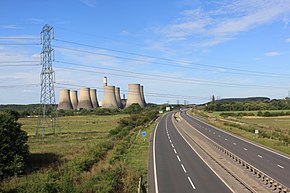| A453 | ||||
|---|---|---|---|---|
 The A453 "Remembrance Way" dual carriageway between the M1 motorway and Nottingham | ||||
| Birmingham-Tamworth | ||||
| Length | 12.4 mi[1] (20.0 km) | |||
| southwest end | 52°31′00″N 1°54′05″W / 52.5168°N 1.9013°W | |||
| Major intersections | ||||
| northeast end | 52°37′44″N 1°42′18″W / 52.6290°N 1.7050°W | |||
| Castle Donington-Nottingham | ||||
| Length | 16.4 mi[2] (26.4 km) | |||
| southwest end | 52°47′52″N 1°22′12″W / 52.7977°N 1.3700°W | |||
| Major intersections | J23a & 24 → M1 motorway | |||
| northeast end | 52°56′43″N 1°09′12″W / 52.9453°N 1.1532°W | |||
| Location | ||||
| Country | United Kingdom | |||
| Road network | ||||
| ||||
The A453 road was formerly the main trunk road connecting the English cities of Nottingham and Birmingham. However, the middle section of this mainly single-carriageway road has largely been downgraded to B roads or unclassified roads following the construction of the parallel M42-A42 link around 1990. The M42 was originally meant to pass further north than it does, and to join the M1 at Sandiacre in Derbyshire. The M42/A42 does not enter Derbyshire, but instead joins the M1 closer to the A453 junction at Kegworth. The A42 shadows the former A453 from Appleby Magna to Castle Donington. The road historically connected the East Midlands with the West Midlands.
- ^ "Directions to Bonehill Rd/A453". Google Maps. Retrieved 12 April 2013.
- ^ "Directions to Wilford Rd/A453". Google Maps. Retrieved 12 April 2013.
